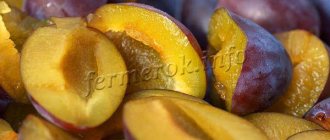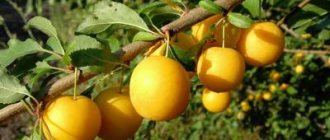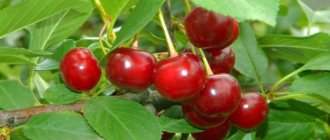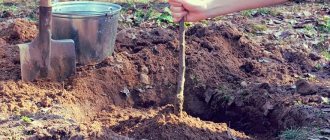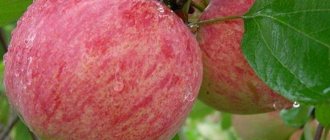Early fruits are always in price. Therefore, lovers of juicy plums choose the Startovaya variety. It was created at the All-Russian Research Institute of Genetics and Selection of Fruit Plants named after I.V. Michurin. For crossing, the Volga Beauty and Eurasia 21 were used. Authorship was secured by G.A. Kursakov, T.A. Nikiforova, T.A. Pisanova and R.E. Bogdanov. Registration date 2000. The variety was included in the State Register of Breeding Achievements of the Russian Federation in 2006. The region suitable for cultivation is recognized as the Central Black Earth (Belgorod, Kursk, Voronezh, Lipetsk, Tambov regions). But plum also has a good reputation in Belarus, Ukraine, Moldova, Estonia and Georgia.
Characteristics of the Starting plum variety
Stanley
plum Starter plum is a domestic variety. Fruiting begins already in the 3rd–4th year after planting and is characterized by a high, stable yield. The yield of plums per hectare is over 60 centners, so this variety is used not only for personal but also for commercial cultivation.
The tree is quite large and powerful. The plum crown is wide, oval-shaped, with abundant foliage. The leaves are wide. The shape of the wrinkled leaf blade is characterized by a pointed end and a finely crenate, ribbed edge. Leaf color is emerald green. Starting plum is characterized by early abscission of stipules.
Plum Starter
The bark has a reddish tint. Wide, curved shoots are colored brown, closer to burgundy, with a slight silvery tint. Brown, cone-shaped buds with pointed ends recede slightly from the stem. The variety is distinguished by a large number of silver-brown lentils. Plum Startovaya has standard, slightly pigmented petioles. Each of them contains 2 amber glands.
Note! Plum Startovaya is self-sterile, so it requires the presence of a pollinating variety.
Abundant flowering begins in April or May. Plum flowers are pure white and large, with a bell-shaped cup. The stigma of the pistil rises above the anthers.
Plum Startovaya is characterized by large fruits, weighing from 45 to 50 g. They have a regular oval one-dimensional shape with a small depression at the base. Plums are covered with a dense skin of medium thickness. The color of the fruit is purple with a characteristic waxy coating, giving it a violet-bluish tint. There are no “freckles” under the skin. Thanks to the properties of the peel, the plum is transportable, does not deform and is not damaged even when transported over long distances.
The variety has amber-colored flesh, sweet and juicy, with a slight sourness. Sugar content is 8.5%. The fruits are distinguished by the abundant secretion of watery, colorless plum juice. The elongated bone comes out of the pulp without difficulty.
Ripe fruits do not fall off on their own, but are easily separated from the peduncle. Plum Startovaya was given a high tasting rating on the expert scale - 4.7 out of the available 5.
Ripe fruits
Plum Startovaya is a universal home variety. It can be consumed directly from the tree, as well as in the form of preparations. When frozen, plums are used as a decoration for cakes, ice cream and other products.
Origin
Plum Startovaya (variety description and photo provided in our publication) has become known since 2006. The variety is quite young, but has already spread widely throughout the country and has found its fans. The originators were agronomists R. E. Bogdanov, T. A. Pisanova, G. G. Nikiforova, G. A. Kursakov. Volga Beauty and Eurasia-21 were used for hybridization. They are also the best pollinators of the Startovaya plum, which will be described in further content. The bred variety received the best qualities from its “parents”: high winter hardiness and fairly large fruits.
At the moment, the plum is widespread in the central part of Russia, Belarus, Ukraine, Moldova and Estonia.
Reproduction
Columnar plum
Plum Startovaya is easily propagated by cuttings or using seeds. The washed seeds are kept soaked in warm water for 72 to 120 hours. In this case, a daily change of water is necessary, as well as mixing the seeds. Dried seeds are stored in a glass container.
6 months before planting, the seeds must be awakened from sleep and stratified. They are mixed with wet sand and kept at temperatures from –10 to +1 degrees. A tree from a seed is capable of bearing fruit in the 6th year, and when planted by cuttings - in the 3rd–4th year.
Planting Plum Starter
Chinese plum - variety description
A temperate continental climate is suitable for the Startovaya plum. Warm, sunny weather enhances the sweetness of the fruit. Therefore, you need to choose a place for planting that is well lit and protected from the winds.
The variety is suitable for loamy soil that has a neutral reaction. To prevent the roots from getting wet, choose a place with a groundwater level no closer than 2 m to the surface. In the spring, plums are planted in April, and in the fall - in October, until frosts begin. After 2 years, the cutting reaches the size of a seedling and, if desired, can be transplanted to another place.
Planting Plum Starter
A couple of weeks before planting the plum, a place is cleared and a hole measuring 60x60x60 cm is made. The dug up soil is not removed, but mixed with rotted horse manure (2 buckets), and ammophosphate (200 g) is added to the mixture. The resulting mixture is poured into the pit in a mound, in the center of which a peg is fixed. The plum seedling is placed in the center of the top of the hill, the roots are carefully straightened. You should not add strong fertilizers, as the roots of the tree may get burned.
Covering with soil is done so that the root collar remains uncovered at a distance of about 5–7 cm above the surface. All that remains is to tie the plum seedling to the support using soft material, trample the soil and water it. The initial watering is 4 buckets of warm, settled water. After this, the area around the trunk circle is mulched with a layer of peat or compost.
How to plant a seed?
Surely, when you were children, you loved to plant seeds from plums and wait for them to sprout. But children’s patience is not the same as that of adults, so the “bed” was soon abandoned without producing a harvest. Do you want a “Starter” plum to grow in your garden, the variety description of which is given above? Then you will have to remember childhood games, get a bone, but be patient and work hard.
The seed must be well washed to remove the pulp and soaked for 120 hours in water at room temperature. The water should be changed every day, and the seeds, if there are several of them, should be washed again and mixed. In the future, they should be dried and placed in a glass container. Only after this do we proceed directly to landing.
They begin to stratify the seeds six months before planting in the ground, mixing them with wet sand. The temperature during such operations should not be lower than -10, but not higher than +1.
If planting is scheduled for spring, then plant in April, if for autumn, then until mid-October, before frost hits. So, we wait two years, do not forget to water on dry days. During this period, an excellent seedling will grow from the seed! In four years, it will turn into a tree and give you ripe plums, exactly the same ones from which you planted the seed six years ago.
Growing and care
You need to care for plums according to the same principle as other fruit trees. It requires loosening, weeding, mulching, watering, fertilizing, pruning. To increase the variety's yield next year, 80% of the young plum flowers are removed.
Tree trunk circle
The trunk circle of a plum tree is about 2 m and requires careful care. Regular loosening and weeding are necessary. In addition, it is recommended to remove root shoots, as they deplete the tree’s strength. Removal should be carried out at least 4–5 times during the summer.
Tree trunk circle
Watering
Watering intensity: from 3 to 5 times during the spring-summer period. For 1 sq.m. 3-4 buckets of water should be used. The most important periods for watering plums are: after flowering, active formation and growth of ovaries, after the completion of pit formation in the fruit. To keep moisture in the soil longer, watering is completed with mulching. For this, dry soil, wood shavings, straw, and pieces of cardboard are used.
Top dressing
Fertilizing of the Startovaya plum is carried out three times a year: in mid-spring, in summer and after harvesting in autumn. Regular feeding of plums with mineral and organic fertilizers begins 2 years after planting. The tree should receive organic supplements at yearly intervals; in intermediate years, mineral fertilizers can be added:
- 10 days before the start of flowering, in April, add about 20 g of urea per 1 sq. m;
- after flowering, in May, the plum is fed with 20 g of double superphosphate, 15 g of urea, 30 g of potassium sulfate per 1 sq. m.
Organic feeding:
- 1 part slurry diluted with 3-5 parts water;
- an aqueous solution of bird droppings in a ratio of 1:10.
Organic feeding
Spring feeding: 80 g of urea, 200 g of potassium sulfate, 200–300 g of superphosphate per 10 liters of water. It is worth taking weather conditions into account when adjusting the frequency of fertilizing. Cold, cloudy weather slows down the absorption of nutrients by plums.
Trimming
Pruning is a mandatory procedure for plum trees, creating conditions for the proper development of the tree. The plum requires sanitary, formative pruning, in which twisted, inward-growing and dry branches are removed. Last year's growth is shortened by one third. The formation of the crown begins in the 2nd year of the tree’s life, making it medium-thick. When the height of the tree reaches 2.5 m, bend the central conductor towards the east, fixing it with a garter to the underlying branch.
Strengthening branches
When the harvest is high, the plum branches are strengthened with supports. To prevent gum deposition, soft material should be placed at the points of contact between the bark and the support.
Preparing for winter
Pre-winter pruning involves shortening long branches by a third and removing damaged branches.
Important! Plum Startovaya perfectly withstands winter frosts, so shelter is not required.
The tree also tolerates the hot summer period well.
Reviews:
Panteleimonov:
I planted Startovaya a year after its appearance. I found information on the Internet and ordered a seedling. Fruiting occurred after 5 years. The fruits turned out to be even larger than promised and exceeded the 60-gram mark. And the taste and smell of the fruits simply attracted you to eat them.
Docha:
I love plums more than other fruits and berries, and every time I bought them at the market, I wondered if I should plant a tree myself. Passing by sellers with seedlings, one man advised me to buy this new variety. Last year I received my first harvest. There were few fruits, but they were large and so tasty that I ate them slightly unripe. Now I'm looking forward to the new harvest of these wonderful plums.
Sable:
The starter tasted great! The first year I had fruit. Its fruits were harvested early, after the hybrid plums - late July, early August, very early for domestic plums. The pulp is sweet (almost without sourness), juicy, yellowish (as I like), the stone separates well. The plum is very large, one piece fits in your hand. The tree is tall, slightly thickened, and needs pruning. The yield was small for the first year, and we had frosts when the plum blossomed. I was pleased with the taste of this plum. This variety was recommended to me at a nursery by a respected professional gardener. I always listen to his recommendations when choosing fruits and his advice is always on point!
Advantages and disadvantages of the variety
The characteristics of the variety indicate its many advantages:
- a high degree of frost resistance, allowing the plum to withstand even harsh winter conditions;
- very early ripening;
- high productivity;
- resistance to most diseases and fungal infections;
- good transportability;
- excellent taste properties.
The disadvantage of this variety is its short shelf life - up to 25 days in a cool room. The self-sterility of the Starter plum can also be considered a disadvantage, since in order to pollinate , compatible pollinating varieties have to be planted at the same time.
The popularity of plums is justified by many positive qualities. Summer residents call this variety ideal for its unpretentiousness, early ripening and high yield, which is not influenced by either climate or weather conditions.
0 0 votes
Article rating
Description of the tree
The starter plum, the description of which interests many gardeners, grows on a tree. It is powerful, decorated with wide, dense, oval-shaped foliage. Its foliage is average. The leaves themselves are medium in size, neatly wide in shape with a pointed tip. They are a beautiful emerald shade, glossy, wrinkled, ribbed at the edges.
The tree produces wide, strong shoots. They are burgundy-brown, with a slight silver tint. The apex is short and pointed. On the shoots there are a huge number of lenticels of brown-silver color.
The petioles are decorated with “freckles” in the form of slight pigmentation. The glands have a tint of amber and are located on each petiole, two pieces.
The tree is especially beautiful during the flowering period. It showers with large snow-white flowers with a pleasant aroma, their calyxes resemble bells.
Read also: Santa Maria pear: variety description, photos, reviews
